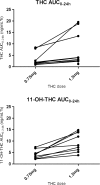Safety, pharmacodynamics, and pharmacokinetics of multiple oral doses of delta-9-tetrahydrocannabinol in older persons with dementia
- PMID: 25752889
- PMCID: PMC4480847
- DOI: 10.1007/s00213-015-3889-y
Safety, pharmacodynamics, and pharmacokinetics of multiple oral doses of delta-9-tetrahydrocannabinol in older persons with dementia
Abstract
Rationale: Data on safety, pharmacodynamics, and pharmacokinetics of tetrahydrocannabinol (THC) are lacking in dementia patients.
Methods: In this randomized, double-blind, placebo-controlled, crossover trial, we evaluated the safety, pharmacodynamics, and pharmacokinetics of THC in ten patients with dementia (mean age 77.3 ± 5.6). For 12 weeks, participants randomly received oral THC (weeks 1-6, 0.75 mg; weeks 7-12, 1.5 mg) or placebo twice daily for 3 days, separated by a 4-day washout period.
Results: Only 6 of the 98 reported adverse events were related to THC. Visual analog scale (VAS) feeling high, VAS external perception, body sway-eyes-open, and diastolic blood pressure were not significantly different with THC. After the 0.75-mg dose, VAS internal perception (0.025 units; 95% CI 0.010-0.040) and heart rate (2 beats/min; 95% CI 0.4-3.8) increased significantly. Body sway-eyes-closed increased only after 1.5 mg (0.59°/s; 95% CI 0.13-1.06). Systolic blood pressure changed significantly after both doses of THC (0.75 mg, -7 mmHg, 95% CI -11.4, -3.0; 1.5 mg, 5 mmHg, 95% CI 1.0-9.2). The median T max was 1-2 h, with THC pharmacokinetics increasing linearly with increasing dose, with wide interindividual variability (CV% up to 140%). The mean C max (ng/mL) after the first dose (0-6 h) was 0.41 (0.18-0.90) for the 0.75-mg dose and 1.01 (0.53-1.92) for the 1.5-mg dose. After the second dose (6-24 h), the C max was 0.50 (0.27-0.92) and 0.98 (0.46-2.06), respectively.
Conclusions: THC was rapidly absorbed and had dose-linear pharmacokinetics with considerable interindividual variation. Pharmacodynamic effects, including adverse events, were minor. Further studies are warranted to evaluate the pharmacodynamics and efficacy of higher THC doses in older persons with dementia.
Figures



References
-
- Ahmed AI, van den Elsen GA, Colbers A, van der Marck MA, Burger DM, Feuth TB, Olde Rikkert MG, Kramers C. Safety and pharmacokinetics of oral delta-9- tetrahydrocannabinol in healthy older subjects: a randomized controlled trial. Eur Neuropsychopharmacol. 2014;24:1475–1482. doi: 10.1016/j.euroneuro.2014.06.007. - DOI - PubMed
-
- Aso E, Palomer E, Juvés S, Maldonado R, Muñoz FJ, Ferrer I. CB1 agonist ACEA protects neurons and reduces the cognitive impairment of AβPP/PS1 mice. J Alzheimers Dis. 2012;30:439–459. - PubMed
Publication types
MeSH terms
Substances
LinkOut - more resources
Full Text Sources
Other Literature Sources
Medical

